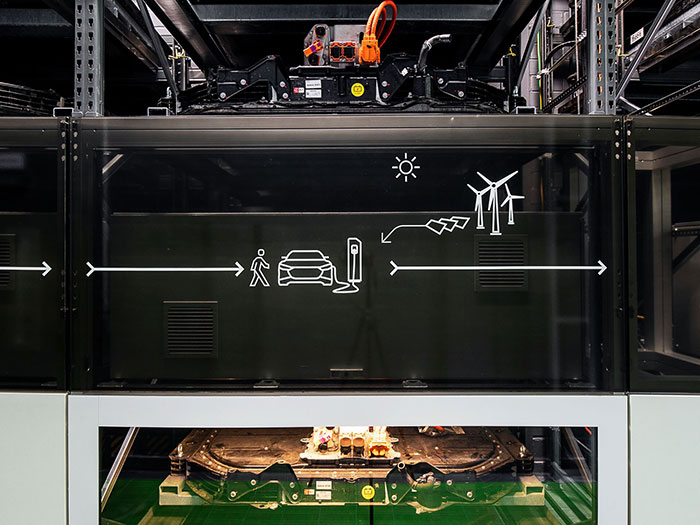E-mobility, a valuable resource for the power grid
Audi doesn’t just develop and make electric cars. It’s also looking for solutions to the broader challenges associated with e-mobility. At the EUREF Campus in Berlin, for instance, experts are testing interaction scenarios between e-cars and the power grid.
The EUREF Campus in Berlin is much more than a mere symbol of sustainability and of the transition to new forms of energy – it’s a research centre focused on solving real problems. Located by the historic “Gasometer” in Berlin’s Schöneberg district, the campus is home to more than 3,500 people working for over 150 businesses, institutions, and start-ups in the fields of energy, transportation, and sustainability.
And last year, it was here that Audi opened Germany’s largest multi-use battery storage unit. The batteries at the unit come from old Audi e-tron development vehicles and have a capacity of 1.9 MWh – enough to power a four-person household for around six months.
A new life

Using old car batteries as emergency generators would be one way to give them a second lease of life. But Audi engineers have something more ambitious in mind: the question they want to answer is: “How can we integrate electric vehicles into the energy transition?”. Dr. Stefan Niemand, Audi’s former head of electrification, answered that very question when he formulated the team’s mission: “The aim is to study two ways in which e-tron batteries can be integrated into the power grid. Firstly, intelligent charging and discharging management while the batteries are still being used in vehicles as portable energy stores. Secondly, the use of second-life battery banks to stabilise the grid and secure the power supply”.
Storing energy
The storage unit at the EUREF Campus allows both of these applications to be simulated, measured, and analysed using large datasets. This is made possible because the team can simulate a scenario where, despite the batteries having been removed from vehicles and linked together, they are installed in separate e-trons and hooked up to the grid to charge.
Audi engineers are testing the resulting network – just one of their ongoing trials. “As the number of electric models rises, so too does the possibility of energy storage,” explains Alexander Kupfer, who works on sustainable product development at Audi. “In the medium term, the total battery capacity of Volkswagen models alone will be around 150 GWh: enough to power an industrialised nation like Germany for around two hours. As cars generally spend 95% of their time parked, it makes sense to try and utilise this enormous potential”.
Towards CO₂ neutrality

If electric cars are connected to the power grid and their storage capacity can be intelligently managed, the resulting network could be used in the future to stabilise and optimise the energy supply, as well as to absorb excess electricity from wind power and photovoltaic systems. This could compensate for fluctuations in the grid, which would otherwise require special facilities. It could also contribute to establishing a CO₂ neutral power supply.
And in order to simulate these kinds of scenarios on a small scale, a model experiment is being conducted with wind farms in Brandenburg and Mecklenburg-West Pomerania. Excess green electricity is buffered at the EUREF Campus, meaning that wind turbines no longer have to be taken off the grid. “For now, our battery storage unit at the EUREF Campus is just a small building block, but in a few years it could play a major role – I’d go so far as to say that e-mobility is crucial to achieving an efficient power grid based mainly on renewable sources”, says Kupfer.
Reusing and recycling
At the EUREF Campus, engineers are also testing ways in which used batteries could be utilised for auxiliary and buffer storage on local power grids. Used e-tron batteries are connected to Berlin’s medium-voltage power grid and contribute one MW of power, helping to compensate for power fluctuations.
What this means is that some batteries destined for recycling could be reused first, and only subsequently broken down into their individual components. Even then, some components, especially metals, would be reused in new batteries.
So, when an electric car reaches the end of its life cycle, its batteries could be ready to embark on two new lives — and will then have a good chance of being reborn all over again.
Source: AUDI AG
